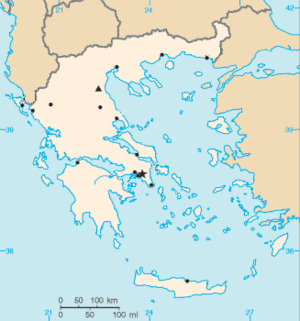Welcome to the Virtual Education Wiki ~ Open Education Wiki
Greece: Difference between revisions
| Line 12: | Line 12: | ||
== Country education system == | == Country education system == | ||
33rd and 34th articles of [http://www.quirinale.it/costituzione/costituzione.htm Italian Constitution] establish the freedom to teach and learn sciences, arts and professions. | |||
The Italian school system at present is based on primary, secondary and higher education. Younger children can go to the nursery school from the age of 3 years until they are 6. This school is not compulsory but is now rather normal to send the childern to these schools. | |||
===Pre-education=== | |||
Nursery schools (Παιδικός σταθμός, Paidikós Stathmós) are popular but not compulsory. '''Kindergartens''' (Νηπιαγωγείο, Nipiagogeío) '''are now compulsory''' for any child above 4 years of age. | |||
===Compulsory education=== | |||
Children start primary school aged 6 and remain there for six years. Attendance at Gymnasia starts at age 12 and last for three years. | |||
The primary level starts at the age of 6 until the age of 11. | |||
'''Primary school''': duration 5 years (6 y/old - 12 y/old children)<br /> | |||
'''Gymnasia School''': duration 3 years (12 y/old - 15 y/old) | |||
After the primary school follows the Gymnasia until 15 years of age. At that age the compulsary education is completed. | |||
===Secondary education=== | |||
Greece's post-compulsory secondary education consists of two school types: | |||
* '''unified upper secondary schools''' (Ενιαίο Λύκειο, Eniaia Lykeia); | |||
* '''technical-vocational educational schools''' (Τεχνικά και Επαγγελματικά Εκπαιδευτήρια, "TEE"). | |||
Post-compulsory secondary education also includes '''vocational training institutes''' (Ινστιτούτα Επαγγελματικής Κατάρτισης, "IEK") which provide a formal but unclassified level of education. As they can accept both Gymnasio (lower secondary school) and Lykeio (upper secondary school) graduates, these institutes are not classified as offering a particular level of education. | |||
The Programme for International Student Assessment, coordinated by the OECD, currently ranks the Greek secondary education as the 12th in the world, being significantly above the OECD average. | |||
== Higher education == | == Higher education == | ||
Revision as of 10:15, 2 September 2008
Greece in a nutshell
Greece, officially the Hellenic Republic, is a parliamentary republic; Greece is in southeastern Europe, situated on the southern end of the Balkan Peninsula. Greece is a developed country, a member of the European Union since 1981, a member of the Economic and Monetary Union of the European Union since 2001, NATO since 1952. Athens is the capital; Thessaloniki, Patras, Heraklion, Volos, Ioannina, Larissa and Kavala are some of the country's other major cities.
Greece's total area is 131,990 km², with a water percentage of 0.8669. According to the NSSG (National Statistical Service of Greece ), Greece's total population in 2001 was 10,964,020; extimated population in 2008 is 11,216,708, the 74th largest population in the World.
Country education system
33rd and 34th articles of Italian Constitution establish the freedom to teach and learn sciences, arts and professions.
The Italian school system at present is based on primary, secondary and higher education. Younger children can go to the nursery school from the age of 3 years until they are 6. This school is not compulsory but is now rather normal to send the childern to these schools.
Pre-education
Nursery schools (Παιδικός σταθμός, Paidikós Stathmós) are popular but not compulsory. Kindergartens (Νηπιαγωγείο, Nipiagogeío) are now compulsory for any child above 4 years of age.
Compulsory education
Children start primary school aged 6 and remain there for six years. Attendance at Gymnasia starts at age 12 and last for three years.
The primary level starts at the age of 6 until the age of 11.
Primary school: duration 5 years (6 y/old - 12 y/old children)
Gymnasia School: duration 3 years (12 y/old - 15 y/old)
After the primary school follows the Gymnasia until 15 years of age. At that age the compulsary education is completed.
Secondary education
Greece's post-compulsory secondary education consists of two school types:
- unified upper secondary schools (Ενιαίο Λύκειο, Eniaia Lykeia);
- technical-vocational educational schools (Τεχνικά και Επαγγελματικά Εκπαιδευτήρια, "TEE").
Post-compulsory secondary education also includes vocational training institutes (Ινστιτούτα Επαγγελματικής Κατάρτισης, "IEK") which provide a formal but unclassified level of education. As they can accept both Gymnasio (lower secondary school) and Lykeio (upper secondary school) graduates, these institutes are not classified as offering a particular level of education.
The Programme for International Student Assessment, coordinated by the OECD, currently ranks the Greek secondary education as the 12th in the world, being significantly above the OECD average.
